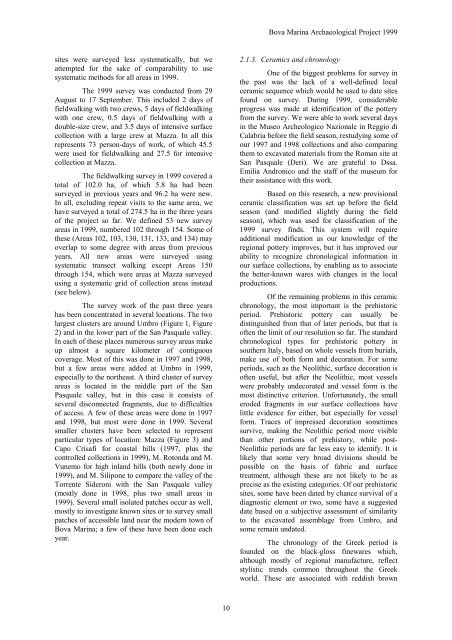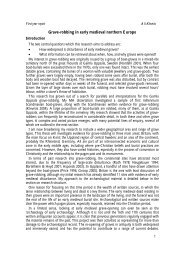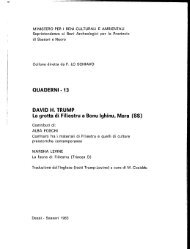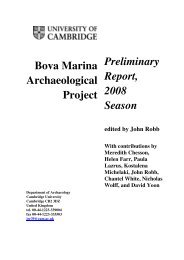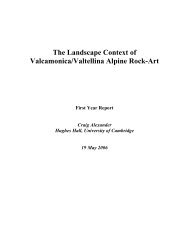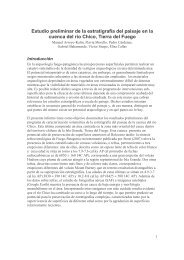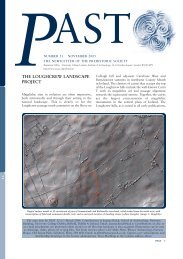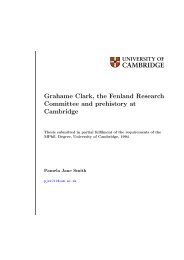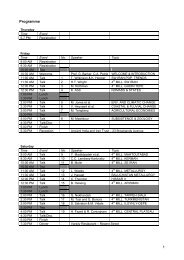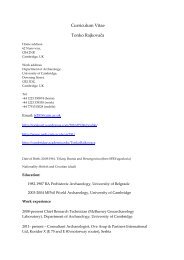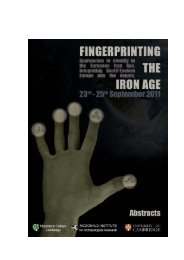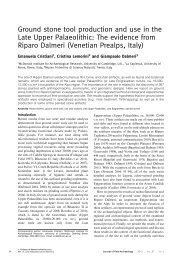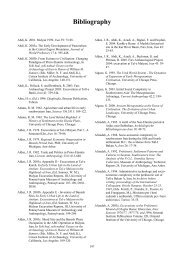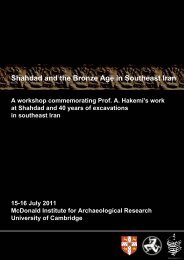Bova Marina Archaeological Project - Department of Archaeology
Bova Marina Archaeological Project - Department of Archaeology
Bova Marina Archaeological Project - Department of Archaeology
Create successful ePaper yourself
Turn your PDF publications into a flip-book with our unique Google optimized e-Paper software.
sites were surveyed less systematically, but we<br />
attempted for the sake <strong>of</strong> comparability to use<br />
systematic methods for all areas in 1999.<br />
The 1999 survey was conducted from 29<br />
August to 17 September. This included 2 days <strong>of</strong><br />
fieldwalking with two crews, 5 days <strong>of</strong> fieldwalking<br />
with one crew, 0.5 days <strong>of</strong> fieldwalking with a<br />
double-size crew, and 3.5 days <strong>of</strong> intensive surface<br />
collection with a large crew at Mazza. In all this<br />
represents 73 person-days <strong>of</strong> work, <strong>of</strong> which 45.5<br />
were used for fieldwalking and 27.5 for intensive<br />
collection at Mazza.<br />
The fieldwalking survey in 1999 covered a<br />
total <strong>of</strong> 102.0 ha, <strong>of</strong> which 5.8 ha had been<br />
surveyed in previous years and 96.2 ha were new.<br />
In all, excluding repeat visits to the same area, we<br />
have surveyed a total <strong>of</strong> 274.5 ha in the three years<br />
<strong>of</strong> the project so far. We defined 53 new survey<br />
areas in 1999, numbered 102 through 154. Some <strong>of</strong><br />
these (Areas 102, 103, 130, 131, 133, and 134) may<br />
overlap to some degree with areas from previous<br />
years. All new areas were surveyed using<br />
systematic transect walking except Areas 150<br />
through 154, which were areas at Mazza surveyed<br />
using a systematic grid <strong>of</strong> collection areas instead<br />
(see below).<br />
The survey work <strong>of</strong> the past three years<br />
has been concentrated in several locations. The two<br />
largest clusters are around Umbro (Figure 1, Figure<br />
2) and in the lower part <strong>of</strong> the San Pasquale valley.<br />
In each <strong>of</strong> these places numerous survey areas make<br />
up almost a square kilometer <strong>of</strong> contiguous<br />
coverage. Most <strong>of</strong> this was done in 1997 and 1998,<br />
but a few areas were added at Umbro in 1999,<br />
especially to the northeast. A third cluster <strong>of</strong> survey<br />
areas is located in the middle part <strong>of</strong> the San<br />
Pasquale valley, but in this case it consists <strong>of</strong><br />
several disconnected fragments, due to difficulties<br />
<strong>of</strong> access. A few <strong>of</strong> these areas were done in 1997<br />
and 1998, but most were done in 1999. Several<br />
smaller clusters have been selected to represent<br />
particular types <strong>of</strong> location: Mazza (Figure 3) and<br />
Capo Crisafi for coastal hills (1997, plus the<br />
controlled collections in 1999), M. Rotonda and M.<br />
Vunemo for high inland hills (both newly done in<br />
1999), and M. Silipone to compare the valley <strong>of</strong> the<br />
Torrente Sideroni with the San Pasquale valley<br />
(mostly done in 1998, plus two small areas in<br />
1999). Several small isolated patches occur as well,<br />
mostly to investigate known sites or to survey small<br />
patches <strong>of</strong> accessible land near the modern town <strong>of</strong><br />
<strong>Bova</strong> <strong>Marina</strong>; a few <strong>of</strong> these have been done each<br />
year.<br />
10<br />
<strong>Bova</strong> <strong>Marina</strong> <strong>Archaeological</strong> <strong>Project</strong> 1999<br />
2.1.3. Ceramics and chronology<br />
One <strong>of</strong> the biggest problems for survey in<br />
the past was the lack <strong>of</strong> a well-defined local<br />
ceramic sequence which would be used to date sites<br />
found on survey. During 1999, considerable<br />
progress was made at identification <strong>of</strong> the pottery<br />
from the survey. We were able to work several days<br />
in the Museo Archeologico Nazionale in Reggio di<br />
Calabria before the field season, restudying some <strong>of</strong><br />
our 1997 and 1998 collections and also comparing<br />
them to excavated materials from the Roman site at<br />
San Pasquale (Deri). We are grateful to Dssa.<br />
Emilia Andronico and the staff <strong>of</strong> the museum for<br />
their assistance with this work.<br />
Based on this research, a new provisional<br />
ceramic classification was set up before the field<br />
season (and modified slightly during the field<br />
season), which was used for classification <strong>of</strong> the<br />
1999 survey finds. This system will require<br />
additional modification as our knowledge <strong>of</strong> the<br />
regional pottery improves, but it has improved our<br />
ability to recognize chronological information in<br />
our surface collections, by enabling us to associate<br />
the better-known wares with changes in the local<br />
productions.<br />
Of the remaining problems in this ceramic<br />
chronology, the most important is the prehistoric<br />
period. Prehistoric pottery can usually be<br />
distinguished from that <strong>of</strong> later periods, but that is<br />
<strong>of</strong>ten the limit <strong>of</strong> our resolution so far. The standard<br />
chronological types for prehistoric pottery in<br />
southern Italy, based on whole vessels from burials,<br />
make use <strong>of</strong> both form and decoration. For some<br />
periods, such as the Neolithic, surface decoration is<br />
<strong>of</strong>ten useful, but after the Neolithic, most vessels<br />
were probably undecorated and vessel form is the<br />
most distinctive criterion. Unfortunately, the small<br />
eroded fragments in our surface collections have<br />
little evidence for either, but especially for vessel<br />
form. Traces <strong>of</strong> impressed decoration sometimes<br />
survive, making the Neolithic period more visible<br />
than other portions <strong>of</strong> prehistory, while post-<br />
Neolithic periods are far less easy to identify. It is<br />
likely that some very broad divisions should be<br />
possible on the basis <strong>of</strong> fabric and surface<br />
treatment, although these are not likely to be as<br />
precise as the existing categories. Of our prehistoric<br />
sites, some have been dated by chance survival <strong>of</strong> a<br />
diagnostic element or two, some have a suggested<br />
date based on a subjective assessment <strong>of</strong> similarity<br />
to the excavated assemblage from Umbro, and<br />
some remain undated.<br />
The chronology <strong>of</strong> the Greek period is<br />
founded on the black-gloss finewares which,<br />
although mostly <strong>of</strong> regional manufacture, reflect<br />
stylistic trends common throughout the Greek<br />
world. These are associated with reddish brown


